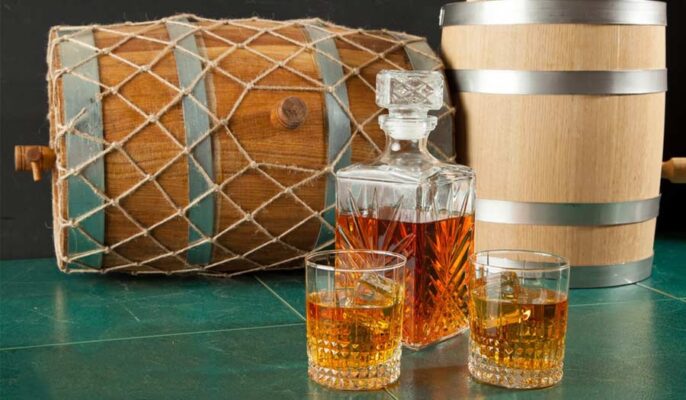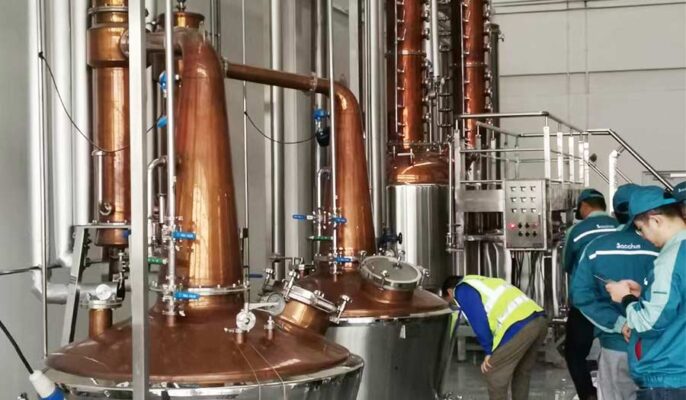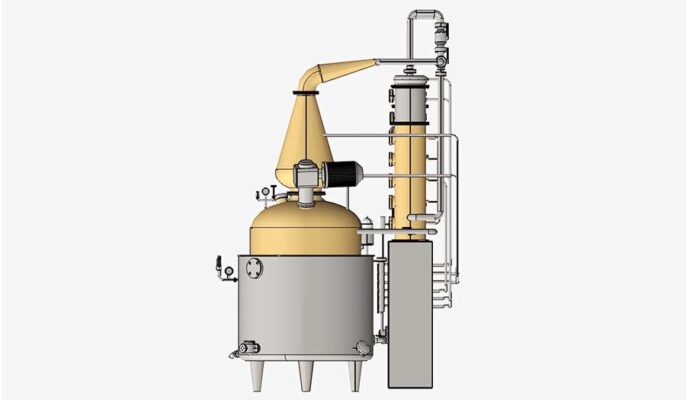맛있는 와인을 만들고 싶다면, 올바른 와인을 만드는 것이 필수적입니다. 증류 장비. 와인 제조 업계의 초보자든 숙련자든 올바른 증류 장비를 갖추면 제품의 잠재력을 극대화할 수 있습니다. 증류는 매시나 와인과 같은 액체 알코올과 같은 액체를 증류기에서 가열하여 발효시키는 것으로 시작됩니다. 액체가 가열되면 알코올이 증발하여 증류기의 상단으로 올라가고, 여기서 수집되어 고농축 용액으로 농축됩니다. 이 문서에서는 장비 선택 및 기타 내용을 포함하여 와인 제조에 증류 장비를 사용하는 방법에 대해 자세히 소개합니다.
증류주란 무엇인가요?
증류주는 알코올 함량을 높이기 위해 가공한 와인입니다. 와인의 알코올은 발효를 통해 생산됩니다. 와인 포도를 으깨어 주스를 추출하는데, 이를 와인 메이커들은 머스트라고 부릅니다. 포도 주스에는 당분이 포함되어 있으며 효모가 첨가되면 알코올로 전환됩니다.
알코올 함량이 너무 높으면 효모가 생존할 수 없으므로 발효 와인의 농도가 자연스럽게 제한됩니다. 그렇기 때문에 알코올 함량이 16%를 초과하는 일반 와인을 찾을 수 없습니다. 알코올 함량이 더 높은 음료를 만들려면 와인을 증류해야 합니다.

기본 원칙 증류 장비
증류는 각 원소의 끓는점에 따라 액체 혼합물에서 서로 다른 성분을 분리하는 과정입니다. 증류 장비는 액체를 가열하여 증기로 만든 다음 액체로 응축하여 알코올과 기타 성분을 분리합니다. 일반적인 증류 장비에는 증류기(예: 일반적인 구리 증류기), 타워 증류 장비 및 환류 증류 장비가 포함됩니다.
- 가열 냄비: 발효 액체를 가열하여 증발을 촉진하는 데 사용됩니다.
- 스팀 발생기: 가열로 생성된 스팀을 응축 장치로 전달합니다.
- 응축기: 냉각수 또는 공기 냉각 시스템을 사용하여 증기를 액체로 냉각합니다.
- 수령 용기: 증류 액체를 수집하는 데 사용됩니다.
증류 및 양조 과정
- 원료 선택: 대상 알코올의 종류에 따라 곡물(보리, 옥수수, 호밀), 과일(포도, 사과), 당밀 등과 같은 적절한 원료를 선택합니다.
- 발효: 원료를 물과 섞어 발효액을 만듭니다. 발효액에 효모를 첨가하면 효모가 당분을 알코올과 이산화탄소로 전환합니다. 효모 균주마다 발효 과정과 최종 풍미에 미치는 영향이 다릅니다.
- 증류: 발효 액체를 증류 냄비에 붓고 가열하여 알코올과 기타 휘발성 성분을 증발시킵니다. 증발된 알코올 증기는 콘덴서에 의해 냉각되어 액체로 재응축되는데, 이것이 증류액입니다.
- 숙성: 특정 온도 및 습도 조건에서 알코올 액체가 용기에 담긴 재료(예: 오크)와 화학적으로 반응하여 복잡한 맛과 향을 만들어냅니다.
- 블렌딩 및 여과: 일관된 풍미를 보장하기 위해 다양한 증류주를 혼합합니다. 알코올의 순도와 맛을 개선하기 위해 여과를 통해 잔류 고형물과 불순물을 제거합니다.
- 포장: 최종 제품은 병에 담아 라벨을 붙이고 밀봉하여 판매할 수 있도록 준비합니다. 포장 전에 품질 검사를 실시하여 표준을 준수하는지 확인합니다.
증류 공정의 유형
- 분별 증류: 이 과정에는 동일한 액체를 여러 번 증류하는 과정이 포함됩니다. 증류는 혼합물에서 다른 물질을 제거하기 위해 높은 온도에서 여러 번 수행됩니다.
- 증기 증류: 증류는 온도에 민감한 화합물에서 모든 원소를 추출하기 위해 수행됩니다. 이 프로세스를 구현하려면 액체를 다양한 끓는 온도에 노출시켜야 합니다.
- 진공 증류: 액체에 존재하는 일부 물질은 끓는점이 매우 높습니다. 이 경우 타워 압력을 낮추는 것이 더 효율적입니다. 이렇게 하면 증기압이 훨씬 낮은 혼합물의 원소가 더 쉽게 증발할 수 있습니다.
양조 공정에 필요한 증류 장비
- 맥아즙 배럴: 이 용기는 맥아를 제어된 온도에서 물과 혼합하고 매싱을 통해 전분을 발효 가능한 당으로 전환하여 맥아즙 발효 과정을 시작합니다. 이 용기에는 바닥이 없는 바닥과 체가 장착되어 있어 사용된 곡물을 액체에서 분리하여 발효할 준비가 된 맥아즙을 생산합니다.
- 발효 탱크: 발효 탱크는 당분을 알코올로 전환하는 데 핵심적인 역할을 하며 효모가 첨가된 맥아즙을 저장하는 데 사용됩니다. 며칠 동안 지속될 수 있는 발효 과정에서는 온도 조절이 필수적입니다. 발효 탱크에는 압력 방출 밸브가 장착되어 있어 발효 과정에서 생성되는 가스를 지속적으로 방출할 수 있습니다.
- 펌프: 소규모 양조장은 수동으로 관리할 수 있지만, 대규모 양조장은 액체를 안전하고 효율적으로 이동하기 위해 펌프에 의존합니다. 일반적인 설정에는 작업을 간소화하기 위해 맥아즙 펌프와 고농도 펌프가 포함될 수 있습니다.
- 포트 스틸: 포트 스틸은 대형 주전자와 유사하며 데킬라나 싱글 몰트 위스키와 같은 강한 풍미의 증류주를 제조하는 데 이상적입니다. 청소와 리필을 위해 정기적으로 가동을 중단해야 하며 효율성이 제한적이지만 독특한 풍미를 제공합니다.
- 컬럼 스틸: 이 증류기는 기둥과 수직 판으로 구성되어 연속 증류가 가능하며 보드카, 럼, 진과 같은 가벼운 증류주에 적합합니다. 팟 스틸의 풍미에는 미치지 못하지만 더 효율적입니다.
- 콘덴서: 증발된 알코올을 냉각하고 응축하는 코일인 콘덴서는 농축된 알코올을 모으는 데 도움을 줍니다. 종종 제품을 더욱 농축하기 위해 추가 증류 과정을 거치는 경우가 많습니다.
- 여과 장비: 백 필터, 필터 카트리지 또는 여과지와 같은 다양한 옵션은 보관 전에 입자상 물질을 제거하고 알코올을 투명하게 하여 품질과 외관을 개선하는 데 도움이 됩니다.
- 보관 및 숙성 용기: 증류주를 보관할 때는 스테인리스 스틸 탱크와 오크통이 일반적으로 선택되며, 병에 담기 전에 증류주를 숙성시키고 풍미를 더할 수 있습니다.
- 깨끗하고 안전한 장비: 청결 유지와 안전 확보는 증류소 운영의 최우선 과제입니다. 적절한 위생 및 안전 조치 장비는 제품 품질과 작업자의 건강을 보호하는 데 필수적입니다.

증류 장비는 어떻게 선택하나요?
유형 증류 장비
상업용 알코올 증류 장비에는 여러 종류가 있으며, 각 장비는 증류 공정에서 서로 다른 용도로 사용됩니다. 크게 포트 스틸, 컬럼 스틸, 하이브리드 스틸의 세 가지 유형이 있습니다. 팟 스틸은 전통적이고 수공예적인 장인 정신으로 유명하며 소량 증류에 이상적입니다. 반면 컬럼 스틸은 연속 증류 공정으로 인해 대량 생산에 더 적합합니다. 하이브리드 스틸은 팟 스틸과 컬럼 스틸의 요소를 결합하여 두 방식 사이의 균형을 맞추고 다용도로 활용할 수 있습니다.
용량 및 크기
증류 장비의 적절한 크기와 용량을 결정하는 것은 생산을 최적화하는 데 필수적입니다. 결정을 내리기 전에 생산 목표, 예상 수요, 사용 가능한 공간을 고려하세요. 생산 요구 사항을 충족하고 과잉 또는 과소 활용되지 않는 장비에 투자하는 것이 비용 효율성을 위해 필수적입니다.
소재 품질 및 구조
상업용 증류 장비에 사용되는 재료의 품질은 성능과 수명에 큰 영향을 미칩니다. 스테인리스 스틸은 내구성, 내식성, 세척 용이성 때문에 일반적으로 선택되는 소재입니다. 고급 구리 부품은 위스키와 같은 특정 증류주의 풍미를 향상시킬 수도 있습니다.
난방 방법 및 온도 제어
원하는 알코올 도수와 풍미 프로파일을 얻으려면 효율적이고 정밀한 가열이 필수적입니다. 가열 방법은 직화 가열부터 증기 또는 전기 가열까지 다양합니다. 각 방법에는 장점이 있으며 최종 주류의 특성에 영향을 미칩니다. 또한 증류 과정에서 일관성을 유지하려면 복잡한 온도 제어 메커니즘이 필수적입니다.
안전 및 규정 준수
알코올 증류에는 잠재적으로 위험한 공정이 포함되므로 안전이 최우선입니다. 상업용 증류 장비를 구매할 때는 안전 기준과 규정을 충족하는지 확인하세요. 현지 및 국제 규정을 준수하는 것은 법적 문제를 피하고 운영자와 소비자의 안녕을 보장하는 데 필수적입니다.

자주 묻는 질문
원재료는 어떻게 준비하나요?
적절한 원재료(곡물, 과일, 당밀 등)를 선택하고 필요한 가공을 수행합니다. 예를 들어 곡물을 으깨서 당화하거나 과일을 착즙하여 주스로 만들 수 있습니다. 원재료가 깨끗하고 와인 제조 요건을 충족하는지 확인하세요.
증류 장비는 어떻게 설정하나요?
발효된 액체를 스틸에 붓고 가열하여 알코올을 증발시킵니다. 증기는 냉각되어 콘덴서를 통해 액체로 변환됩니다. 증류 과정이 원활하게 진행될 수 있도록 적절한 가열 온도와 응축 조건을 설정합니다.
증류 과정 중 거품은 어떻게 처리하나요?
거품 억제제를 추가하거나 거품 차단기를 사용하여 거품이 넘쳐 증류 효과에 영향을 미치는 것을 방지하세요. 과도한 거품이 발생하지 않도록 스틸의 액체 레벨이 적절한지 확인합니다.
증류 효율을 보장하는 방법은 무엇인가요?
분리탑, 응축기 및 기타 구성품의 상태를 정기적으로 점검하여 깨끗하고 양호한 작동 상태를 유지하세요. 분리 효과를 최적화하기 위해 분리탑의 환류 비율과 가열 파라미터를 조정하세요.
장비를 청소하고 유지 관리하는 방법은 무엇인가요?
장비 제조업체의 청소 및 유지 관리 지침을 따르고 스틸, 콘덴서 및 기타 주요 구성품을 정기적으로 청소하세요. 장비의 기능을 정기적으로 점검하여 모든 부품이 제대로 작동하는지 확인하세요.




